You’ve heard it before:
Data is the world’s most valuable resource.
We’re creating so much data that it’s becoming difficult to put into perspective.
But, let me try:
There are 40 times more data in the digital realm than stars in the universe.
Pretty wild, right?
Just take a look at the growth of digital information created over the last 11 years.
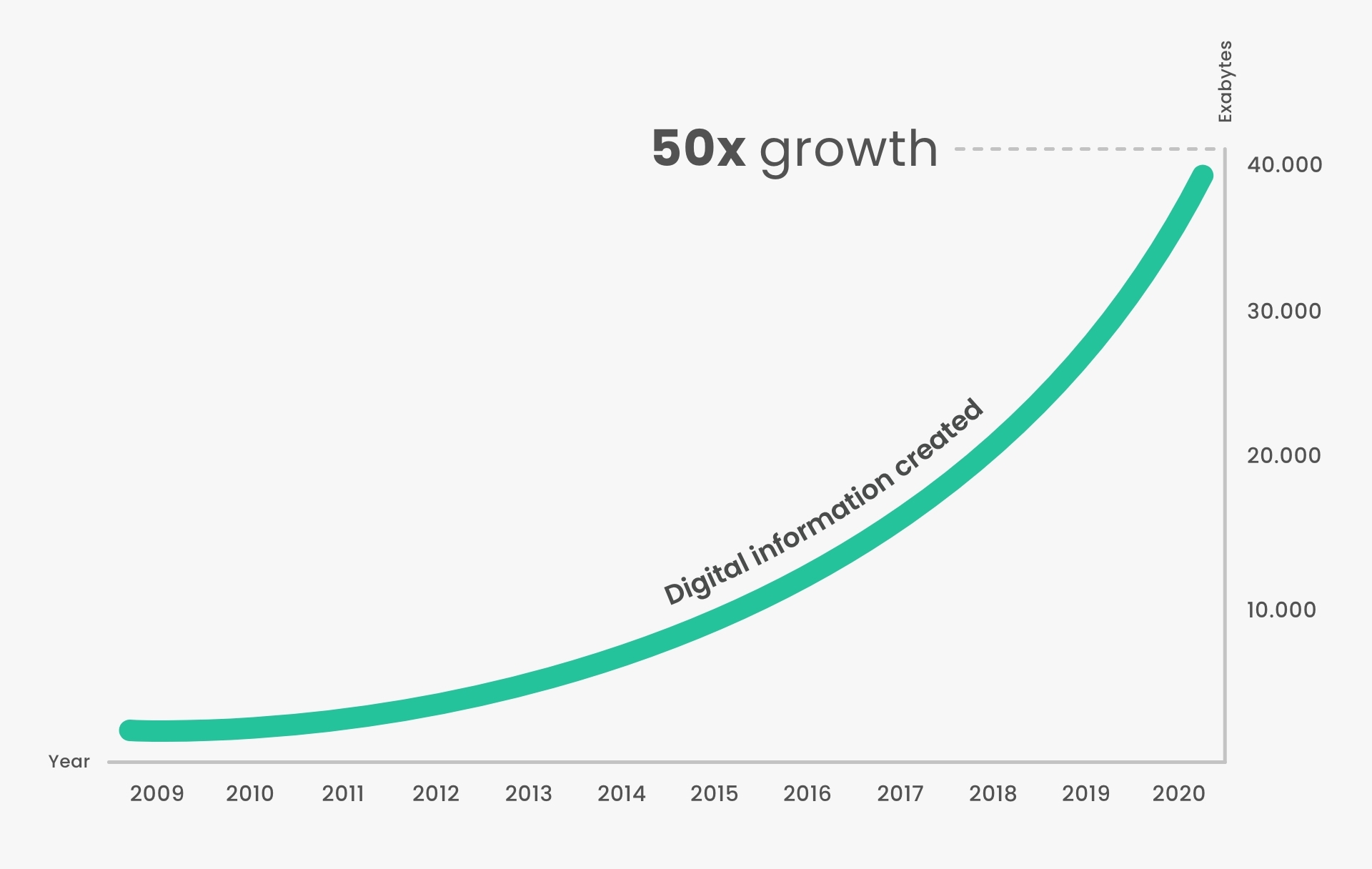
It’s NOT slowing down.
Bur make no mistake – having access to this much data is a good thing.
The more data you have, the more action you can take.
Data steers you in the right direction.
However, if you measure too many metrics, it’s hard to know what course of action to take.
Relying on instinct isn’t enough to guarantee results when prospective customers have more choices now than ever before.
So, what’s a sales team to do?
The answer:
Find relevant data through a repeatable process while understanding what your buyers want.
That’s how you form sales cycles that achieve your main goal: sales.
This guide shares the importance of using data to make smarter sales decisions. It shows the data you need to collect, plus practical tips on how to leverage data to make better decisions.
The importance of data-driven sales decisions
Sales reps love to to act off gut instinct.
However, your gut might not always be right.
Using data to make sales decisions reduces the risk of gut instinct proving to be wrong. The more data you collect, both past and present, the more you’re able to reach leads and prospects in the right channel, with the right message at the right time.
According to research, McKinsey found that 53% of fast-growing sales teams are more effective at using data to drive their sales strategy.
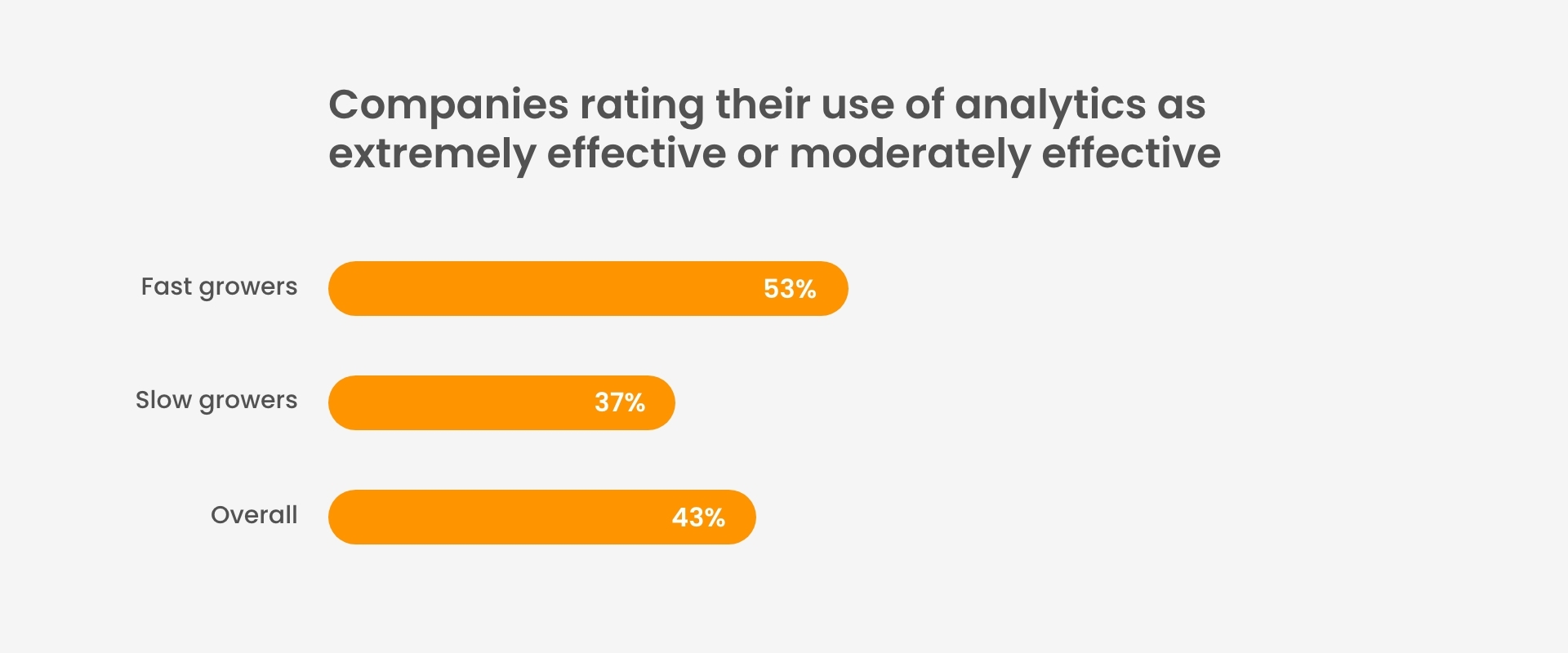
Simply put: Data-driven decision making helps you sell better.
How to find sales data
Every data-driven sales decision starts with data.
But where does that data come from?
The fun part is that ,any salespeople unknowingly sit on large amounts of data they can use to make better, more informed decisions, and become more profitable.
CRM
Your customer relationship management (CRM) platform is a data goldmine. The vast majority (91%) of companies with more than 11 employees are using a CRM to store customer data, follow-up with leads, and qualify potential customers.
Yet with so much information to pull from, which metrics do sales teams need to keep a close eye on? Some of the most important include:
- Deal stage. Where in your sales pipeline is your customer? How fast are they moving through each sales stage? Using your CRM dashboard to track the status of every deal puts you in control of the sales process for more successful outcomes.
- Total active deals. How many deals are being made or finalised? What’s your average deal size? Indicators like these can inform whether you need to step it up when it comes to capturing leads, or whether you have more bandwidth for outreach.
- Sales cycle length. How long does it take to complete the customer journey? How can you use this data to shorten the process and increase efficiency? A robust CRM system will make data visualization easier.
- Customer lifetime value (CLV) forecasts. Set weekly or quarterly sales goals to help measure your progress. Use the data in future sales and marketing strategies to help you understand how much you spend on acquiring each customer.
(GetAccept integrates with 15 CRM’s. Check them out here to collect more data to support your decision making process)
Email marketing platform
Email is for marketing teams only, right?
Think again.
Email marketing is a powerful tool, regardless of which department you sit in.
Here’s why:
An email marketing platform provides insight and data into buyers wants, needs, and motivations. How?
- Open rates. Open rates show which pain points prospective customers are looking to solve or what interests them. For example, let’s say you send two separate email campaigns on digital signature and B2B sales trends. If one email gets more opens than another, that’s your chance to reach out and share related content, strengthening your relationship.
- Click-through rates. It’s one thing for buyers to open an email, but what links are they actually clicking on? Are they clicking on a contact button but not actually contacting you? Are they clicking on free guides but not clicking on links that lead to more content? This data helps you become more proactive in your outreach.
(Use HubSpot, Marketo or Salesforce for email marketing? Use our integrations here).
Website analytics
Website analytics show how people are engaging with your website.
Great for marketing teams – and great for sales teams, too!
Website analytics presents a huge opportunity for sales teams to collaborate with marketing when providing feedback from the trenches to improve messaging, lead quality and close rates.
Let’s see how:
- Messaging: The way buyers’ reference and talk about your company can help the way you communicate on your website. Sales reps sit day in, day out with potential customers and this kind of feedback, shared with marketing, can help you nail down what makes your product and service unique.
- Forms: Sales blame marketing, and marketing blame sales. That’s what happens when lead quality is poor. How do you improve lead quality? Ask the right questions on your forms. You can include fields like the following to get better data before sales teams reach out:
- Are you currently looking for a [X] solution?
- How much do you typically spend on [X]?
- What is your biggest challenge when it comes to [X]?
- Close rates: When you start analyzing data on why buyers visited your website, why they signed up and requested a meeting and what challenges their organization is faced with, you begin to understand how your product and service can help them. The sooner you demonstrate value, the sooner they’ll trust you (and buy from you).
(Check our integrations if you’d like to connect GetAccept with Google Analytics).
7 tips for making data-driven sales decisions
You’ve gathered your data from all the best data sources.
Now it’s time to put them to work and get a better understanding of what your potential customers want.
One of the biggest objectives to keep at the forefront as you make business decisions is to always know what your biggest source of value is. What’s bringing you the most sales? How can your objectives for each quarter help support and fuel its growth?
Here are seven tips to help you navigate the decision-making stage.
- Set your main objective beforehand
- Shift the focus from lagging to lead
- Segment your customer data
- Automate data collection
- Combine quantitative and qualitative data
- Establish data ownership
- Create one source of truth
1. Set your main objective beforehand
Setting your main objective before diving in isn’t only a no-brainer, it’s a must. It’s the best way to ensure your team is working toward a common goal, while also boosting the odds of hitting your key performance indicators.
Your sales teams’ main objective needs to relate back to overall business goals. What’s the number one profit generator for your business? That’s one place to start.
Sales objectives might be:
- Generate high-quality leads at scale
- Improve sales conversion rate
- Increase profit margins
- Increase customer retention
- Reduce churn rate
Follow the SMART goal framework when setting these objectives. For example, yours can be as simple as “Increase lead generation by 15% in Q1.” It doesn’t have to be overly complex, but it does have to be clear.
From there, it’s a matter of breaking down your objective into actionable steps and distributing those to team managers. The process can look something like this:
- Establish the overarching goal your business needs to achieve.
- Prioritise the tasks you need to take to get there.
- Specify what it takes to fulfill each task.
- Distribute those sales objectives to decision-makers and sales reps.
2. Shift the focus from lagging to leading indicators
One of the best ways to slow down your sales progress is by putting too much emphasis on lagging indicators rather than focusing on leading indicators.
What marks the difference?
- Leading indicators focus on future outcomes (think satisfaction and loyalty).
- Lagging indicators focus on the past to determine results (think revenue and overall sales results).
Though leading indicators are harder to pinpoint than lagging indicators, they help you grasp a more comprehensive understanding of your company’s performance.
For example, you can measure churn rate, but that’s a lagging indicator – it’s already happened. But customer retention rates, that’s now, that’s a leading indicator and something you can work towards improving to influence future success.
3. Segment your customer data
Gathering data is a good start. Interpreting it is a whole other story.
That’s where instance segmentation comes into play. It breaks down your entire dataset into themes and categorises customers based on traits they share.
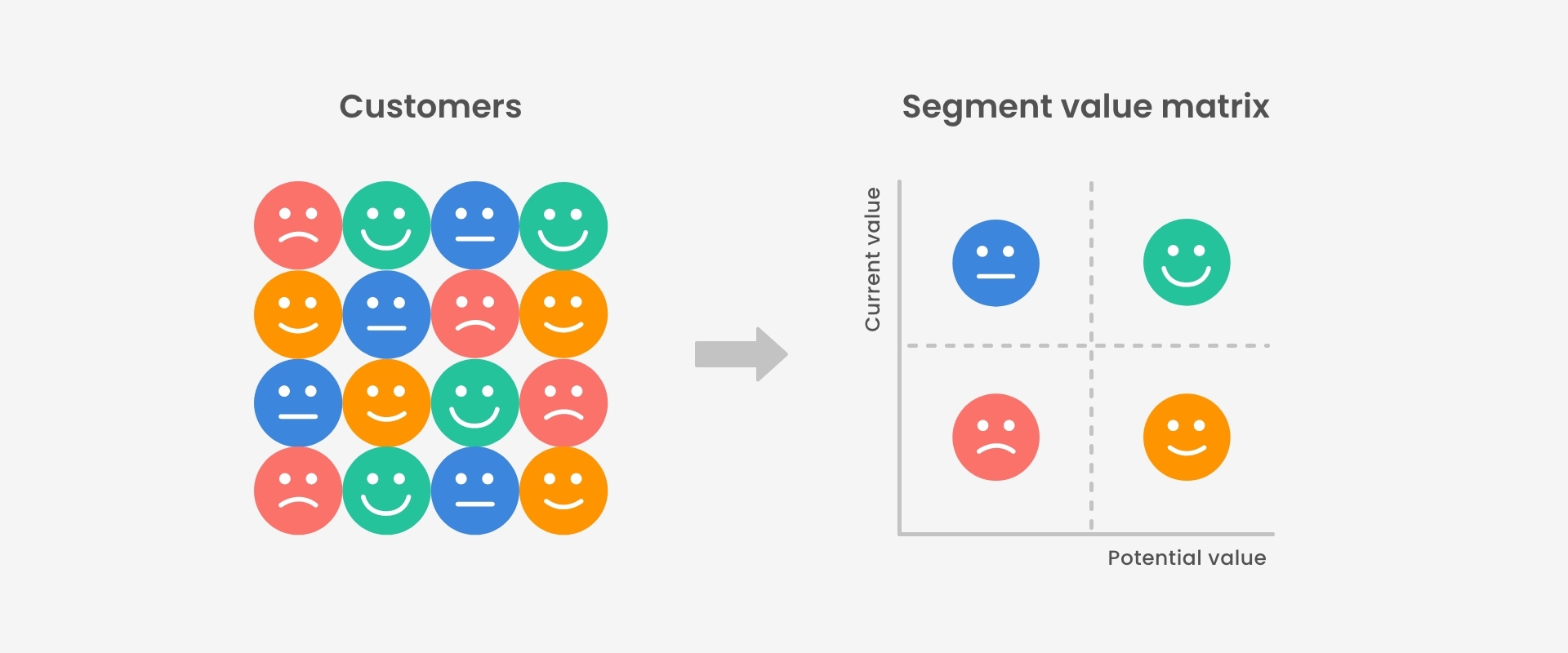
For example, you could create customer personas around:
- Demographic data, such as age, location, income, or job title.
- Behavioral data, such as response time, social media activity, or email open rates.
Let’s put that into practice and say you’re deciding on the best time to reach out to a new lead.
Their job title is “Director of Sales” and they’re based in Brighton. After looking at data for that customer segment, you realise that most people who fit that criteria are more responsive between Tuesday and Thursday. You also know they use LinkedIn frequently.
Here’s what you can do with that data:
- Send a connection request on LinkedIn on Monday
- Send an introduction email with no ask on the Tuesday
- Call them on Thursday
As opposed to cold calling them out of the blue or sending a Calendly invite – and being ignored.
4. Automate data collection
Scrap the sticky note reminders for “update sales data”.
Automation is your best friend.
Not only does it free up your sales team’s time so they can focus on higher ROI tasks, but it also speeds up the process of getting customers through the sales pipeline.
So, which online tools can you use to automate your sales process? Better yet, are you using the best digital sales room for the nuances of your particular sales process?
GetAccept is designed to simplify the way your sales team sells.
Take Sonic Telecoms, for example. Since their reps started using GetAccept, they've been more optimistic about hitting their quota because they have a tool that is designed to make it easier for them. Their sales process is now automated with the help of the API, which means their reps can focus on closing more sales - rather than manually updating their CRM.
5. Combine qualitative and quantitative data
Unfortunately, not everything falls neatly into black and white classifications.
It’s no different when you’re talking about sales. Combine both quantitative (numerical) and qualitative (thoughts and feelings) data to arrive at sensible conclusions.
For example, quantitative data could be the number of customers that have done business with a competitor in your industry. Combine that with qualitative data, like customer sentiments for that competitor, as a way to personalise sales strategies to that market segment.
Both types of data deliver better customer experiences—something that 86% of customers are willing to pay more for. It might be the reason why more than 1,900 business professionals are prioritizing qualitative KPIs like customer experience over pricing or product.
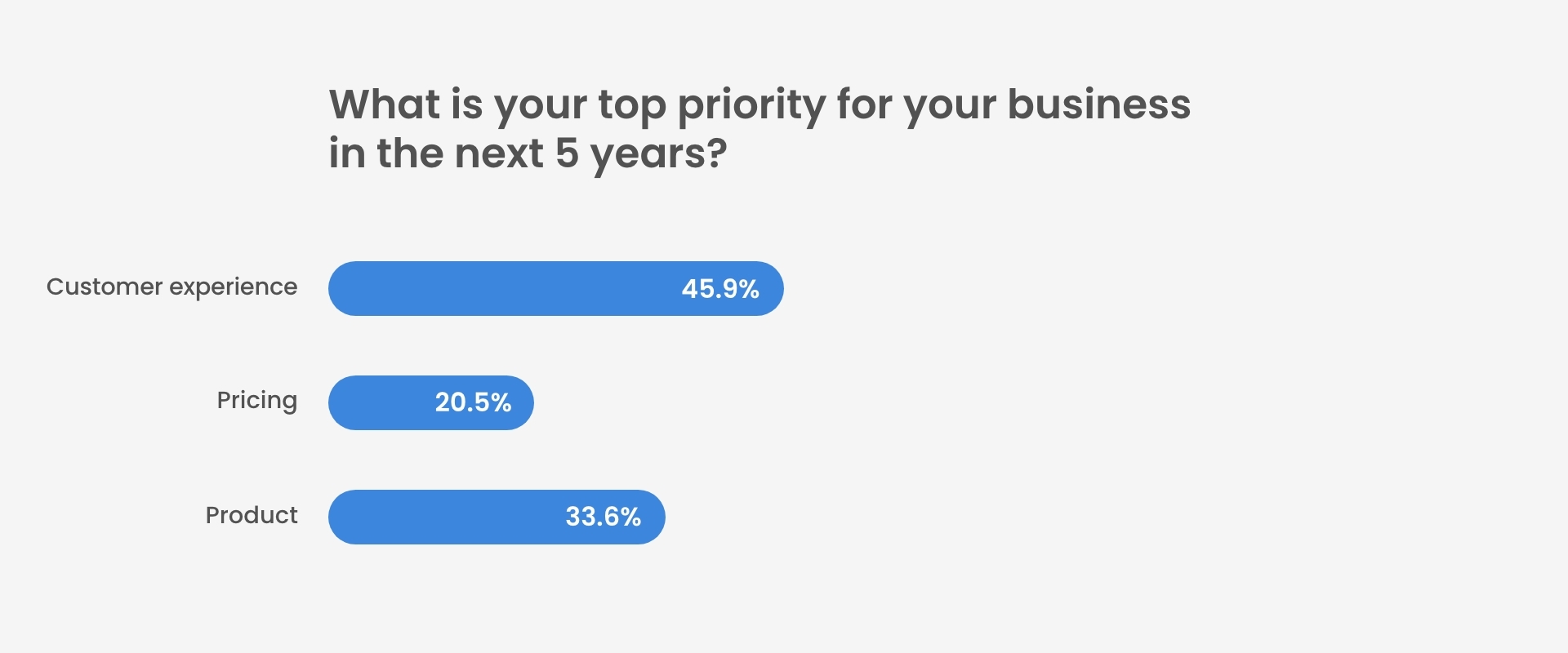
6. Establish data ownership
With data, specificity is your best friend—in both the management and sourcing of it.
Who is responsible for gathering what data?
Who can the most recent updates and changes be tracked back to?
This process will not only help involve your sales team and fill them with a sense of ownership of the whole sales process, but it will also encourage commitment to outcomes.
A sales manager usually owns this data ownership roadmap. Yours could look like this: “Sarah will be in charge of tracking quarterly KPIs and keeping up with new lead counts every week. Adam will be in charge of aggregating yearly KPIs to present bigger picture data at the end of Q2.”
Teams draw out a plan and get specific on the who, what, when, and where of the process of gathering, aggregating, and organizing data.
No “who’s managing this?” questions necessary.
7. Create one source of truth
Gather your data, but also make sure it’s organised, so your team can leverage it to get buy-in.
A central source of truth that’s accessible to anyone that needs it is a surefire way to avoid miscommunication, keep everyone on the same page, and eliminate errors that slow you down.
But it’s getting tricky – as the number of customer data sources is growing, up from 6 sources in 2020 to double (12) by 2022.
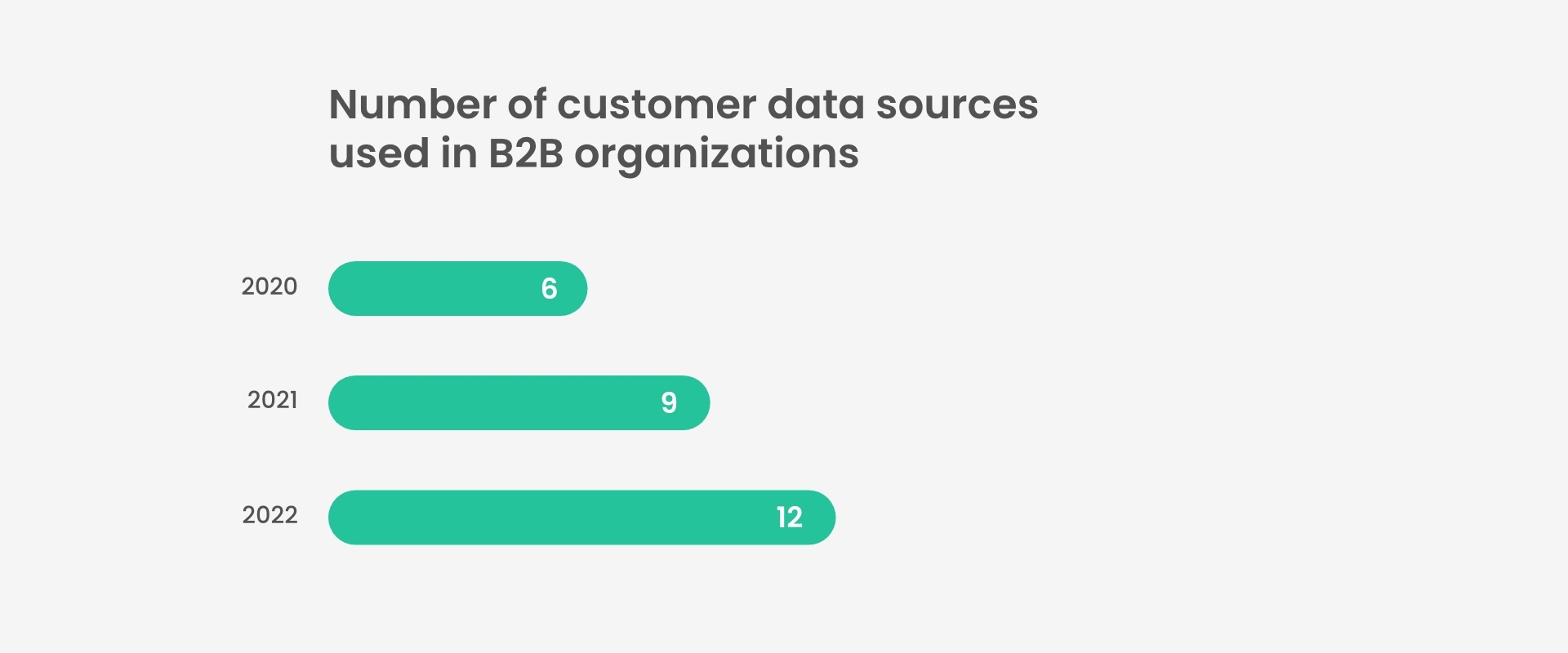
It’s creating a silo’d effect within sales and marketing teams, resulting in a poor buyer experience.
More than 70% of customers expect sales reps and AE’s to have the same information on them, yet close to 60% feel like they’re communicating with different departments or worse, different organizations.
This can, and should be, easily avoided.
Creating a single source of truth could be as simple as establishing a digital sales room where you can share trackable sales content, the latest data, trends, inferences, and results, as well as upcoming information. You could also use it as a way to answer FAQs from prospective customers and leads.
A single source of truth makes it easier to communicate changes and make decisions quickly, with minimal miscommunication to the buyer.
Data-driven decision making is possible with the right tools
When you put “data-driven” and “sales decisions” in the same sentence, magic follows.
The key is being consistent about the data you gather, how you analyze it, and how you iterate on results. It’s no secret companies that rely on data rather than “sales intuition” or “gut feelings” are on track to better outcomes in the form of more sales and lower expenses.
Yet, to successfully adopt a data-driven approach, it’s necessary to empower your team with the right tools to reduce the friction between collecting data and taking action.
That’s where GetAccept comes into play as a key part of your data-centered approach to sales.
Get a free GetAccept demo to learn exactly how we can help your business make better sales decisions with plenty of data.




